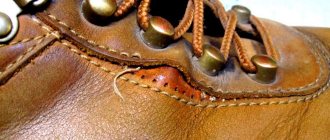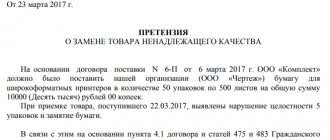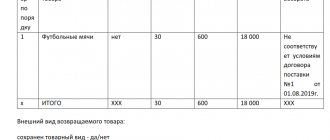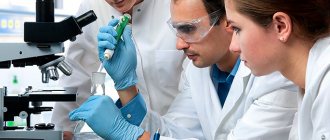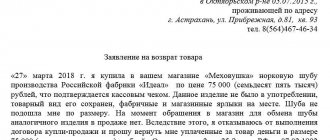Shoe inspections are carried out quite often. It is required in cases where the seller refuses to return money for a product that has become unusable. In this case, it is possible to prove a defect, a manufacturing defect, only through an independent assessment. Knowledge of information about how an independent assessment is carried out and what its features are will help the buyer in protecting their rights. The cost of an independent examination depends on a number of factors that can be assessed independently.
Requirements of a buyer who has identified low-quality shoes
The buyer, in accordance with the law on the protection of consumer rights, may require the seller to take a number of actions aimed at compensating for the material damage incurred:
- exchange of low-quality goods for similar ones;
- exchange of goods of inadequate quality for a similar product of a different brand with or without additional payment;
- return of a defective pair of shoes with payment of the money spent on it;
- repairs within the warranty period.
For this purpose, the buyer sends a written application to the seller, attaching a receipt for the purchase, and provides the product itself. The absence of a receipt cannot be a reason for refusal to consider the application. It is issued in two copies, one, with a delivery stamp, remains with the buyer. Considering that there is no legally established template, it is compiled in any form.
The seller is obliged to accept the application and review it within 30 days. During this period, the shoes can be sent to them for examination. The expert center is chosen by the seller, and if, based on the results of the study, it is concluded that the buyer is at fault for bringing the goods to inadequate quality, he is obliged to reimburse the store for the costs of the expert’s services.
In such a situation, the buyer has the right to conduct a re-examination in an independent institution, which he informs the seller about in writing. He must be informed about the place and time of the examination for possible participation. The notification form is free. The main thing is to convey information about the refusal to accept the expert’s conclusions, a reminder of the essence of the dispute, and notification of the timing of the study.
The buyer himself can insist if the seller does not want to return the money and admit the fact of the defect. If the shoes purchased were quite expensive, then the cost of the examination will pay for itself. In addition, the expert’s conclusion that the shoes have become unusable as a result of the fault of the manufacturer, and not the consumer, makes it possible to impose on the seller the obligation to pay for examination services.
What shoes are considered to be of poor quality?
The law defines a product of inadequate quality as having defects that the person did not know about at the time of purchase (Article 475 of the Civil Code of the Russian Federation). They can be either irremovable, or require significant investment of time and money to eliminate, or are repeated many times.
For example, a consumer purchased a pair of leather autumn boots, but after a couple of days of wearing them, the soles peeled off. Such shoes are classified as a product of inadequate quality, since they have hidden, irreparable or difficult to eliminate defects that prevent them from being used for their intended purpose.
Important : if after purchasing shoes the consumer decides that the color, material or style does not suit him, he cannot return the money or exchange the purchase as a defective product.
What is considered a defect in shoes?
At the time of purchasing and trying on shoes, the buyer likes them.
It is not for nothing that among the variety of models, the one that fits perfectly and suits all parameters is chosen. Often only during use can flaws or defects be discovered that make the shoes unsuitable for further use. They arise due to the manufacturer’s desire to make a cheaper version of a popular product. The desire to increase profits leads to the release of defective products. The main defects of shoes are considered to be:
- rapid thinning of material, such as leather;
- change in product color;
- getting wet when used in low humidity conditions, especially for shoes made of natural materials;
- staining of the foot or sock during use;
- unsticking of the sole, breaking of the heel;
- the appearance of cracks in the material;
- defects in joints;
- protrusion of threads, tearing of lining material, rough seams.
These are the main reasons for returning shoes or sending them for examination.
Defects can be classified according to what they affect:
- in terms of their impact on reliability and functionality, they can be production, post-production, depending on the selected material;
- in terms of their impact on ergonomic properties and safety, defects are associated with the product material or pre-production measures;
- by aesthetic appearance, problems in the finishing of the product or shortcomings in design features are identified.
Moreover, each type of defect can be removable or not. The possibility of returning shoes to look like new becomes an indicator of their quality.
What does the expert examine?
Specialist experts will analyze the microbiological and physico-chemical characteristics of the packaging. The material of the lining and upper of the product, as well as the components of the sole, are checked for compliance with technical standards.
The match of size, shade, pattern, sole thickness, insoles length, height of each product from the pair is specified. The stability of the pad and the slip level of the lining are determined.
Rules for conducting the examination
For examination, shoes are submitted in pairs, even if a defect is found on only one low shoe. The specialist’s conclusion will be made after a comprehensive study of the material and will be based on the low shoe whose performance is worse. The expert himself has knowledge in the field of research, as well as commodity science and legislation in this area. He is a qualified specialist who knows methodological recommendations and has extensive practical work in the field of assessment.
The procedure can only be carried out in special organizations that have received a license for this type of activity in accordance with established methodological recommendations.
To conduct a study, it is necessary to submit an official application describing the identified deficiencies in shoes, which must be accompanied by a number of documents:
- Agreement for the sale of the product (if any).
- Cashier's check.
- Instructions for using the products.
- A receipt for the repairs performed indicating the type of work.
- A detailed description of the claim to the quality characteristics of the shoes.
After a formal complaint is filed, the shoes are sent for analysis.
The examination may be laboratory or organoleptic. Its purpose is to identify defects in shoes and give a conclusion that they have become unusable due to the fault of the manufacturer or buyer who does not take good care of them.
As a result of the activities carried out, the following questions are answered:
- what shortcomings does the product have?
- how the identified defects arose;
- what led to problems - manufacturing defects, pre-sale defects related to the conditions of delivery, storage or use.
This information is reflected in the expert’s final report.
An expert examines the properties of the pair and tests the material for toxicity. The content of harmful substances indicates a desire to reduce the cost of production through the use of low-quality material.
Every shoe in the pair is carefully compared. The blanks must have equal length, shade and pattern. The heel is checked for stability, the insole is checked for abrasion. The pad must be safe and physiologically correct.
Product packaging is also assessed. The information contained on it must coincide with the materials actually sent for analysis. It contains information about the purpose of shoes (men's, women's, children's), operating conditions, and the material used (rubber, leather, suede).
Any examination of flaws in shoes should classify them as belonging to one of the following categories:
- Products with minor flaws that do not interfere with their use. In such products, minor shortcomings are revealed, which in their totality do not affect the wear resistance, durability, or quality indicators of the shoes.
- Products with serious defects, which in the aggregate are not considered critical. The quality of the products is recognized as adequate. An example would be cases of subsidence of the backdrop or cracks in the top of the workpiece.
- Products with critical defects, the presence of which makes it obligatory to return them to the manufacturer to eliminate the identified deficiencies. Such defects include: torn heels, cracking leather or suede, unfinished or rough, incorrectly made seams.
Depending on the conclusions made by specialists, the consumer decides whether to return products to the store.
Complaint/Application Process
Having decided where to apply and having approved the candidacy of an expert, you should properly prepare all the documents necessary for the study.
Choosing an organization
The company conducting the examination offers the client who contacts it to enter into an agreement for the provision of services. This is an important document that should not be neglected under any circumstances. The contract stipulates the cost and timing of the research, and may also list questions that the expert will answer.
Documentation
The application for a commodity examination indicates the date of preparation, last name, first name, patronymic, passport data, as well as the address of the applicant, describes the identified defect in the product and provides questions posed to the expert.
How is it carried out?
The verification itself contains a number of mandatory steps, but its methodology directly depends on the questions asked. First of all, the presented product is inspected, and the sample being studied is often photographed at the same time. After this, the expert conducts a study that allows him to draw a conclusion about the presence or absence of a defect and answer the questions posed.
Manipulations with an item can be recorded using photo and video equipment.
Without actually examining the product, no conclusion can be made about its quality. And only then an expert opinion is created.
It should contain the following information:
- start and end dates of the study;
- place and basis of the event;
- information about the customer;
- information about the expert indicating his qualifications;
- description of the product under study (quantity, characteristic features);
- questions posed to the expert;
- methodological basis;
- list of tools and technical means used;
- a detailed answer to each of the questions posed;
- list of applications (if available).
At the end of the conclusion there must be the expert’s signature and its transcript. The completed conclusion can be delivered to the applicant personally or sent by mail to the address specified in the agreement/application. If photography or video recording was carried out during the study, the materials are compiled in the form of separate attachments.
Refund methods
An item purchased in a store that does not fit due to poor quality may be returned to the seller.
You can return previously spent funds in several ways:
- contact the seller with a request for a refund for a defective product. Must be submitted in writing. A complaint to the book of complaints and suggestions is not regarded as a request for a refund;
- if the seller refuses to conduct an independent examination of the product independently or require the store to conduct it. The conclusion that the product is of inadequate quality and cannot be used is reflected in the expert’s conclusion. Presentation of this document to the seller should serve as the basis for a refund and compensation for the costs of the expert’s services;
- refusal to pay will be grounds for filing a claim in court. Based on its results, you can not only return the money spent on the purchase, repairs and services of an expert, but also receive compensation for moral damage caused.
Confidence that the consumer is right always leads to reimbursement of the amounts spent. The main thing is to use all available methods of protecting rights.
Where to contact
Based on the Federal Law No. 2300-1 , the quality of the product must be assessed by an expert who gives his opinion.
Moreover, if the consumer does not agree with the result, he can order an independent examination from another specialist.
Important! An “independent” examination is a procedure carried out by an organization, the results of which were approved by both the seller and the buyer.
Who has the right to conduct an examination of shoes in Moscow and other localities of the Russian Federation (general provisions):
- The RF Chamber of Commerce and Industry (Chamber of Commerce and Industry) is conducting a study of imported goods.
- OZPP is a civil organization.
- FSE is a non-profit partnership, responsible for conducting various examinations, incl. and merchandising.
- Independent expert centers.
Under what conditions is it possible for expert organizations to operate:
- Have economic (laboratory) and legal conditions for issuing documents and carrying out procedures.
- Provide documents according to existing regulations.
- Have qualified personnel.
- Have accreditation, a fund of regulatory documents, Sanitary Regulations, GOSTs, federal norms and rules.
Since 2011, expert centers are not subject to mandatory licensing.
But accreditation must be in the manner established by the regulations with provision to the national authorities. accreditation body for related information.
Cost and timing of footwear examination, regional differences
You can find out how much an independent shoe inspection costs by analyzing a number of factors. The determining factors will be:
- type of footwear being studied;
- identified defects by their volume - extensive damage to a pair or pinpoint defects;
- region;
- urgency of the examination;
- number of couples studied.
The national average price ranges from 2 thousand to 6 thousand rubles. It will cost from 4 thousand rubles to check boots, boots, over the knee boots. Prices for checking shoes, ballet flats, and sports shoes begin at 3000. There is no specific tariff for prices.
The final information about how much a shoe examination costs is influenced by the diagnostic methods used - whether only organoleptic tests will be used or laboratory tests will be added. In addition, the cost of an independent examination is significantly influenced by the cost of the pair of shoes being examined at a particular moment.
Differences in the conduct of studies may not be significant. The specialist relies on current regulations. An independent merchandising examination of all shoes must be carried out by an organization not associated with either the store or the buyer. The objectivity of the study is proven by granting the right to participate in the study to both interested parties. Choosing where to take the examination can be difficult due to the large number of offers.
In Moscow, a similar procedure is carried out by the Expert Research Laboratory and the Federation of Forensic Experts. In the Northern capital, there is the St. Petersburg state budgetary institution “Center for Quality Control of Goods (Products), Works and on the Fontanka. In Rostov-on-Don - EU Donekspertiza. There are similar organizations in the CIS countries, for example, the Forensic Expert Board operating in Minsk and Gomel.
The time spent independently assessing the quality of footwear will depend on the capabilities of the chosen center and the desired goals. The assessment, which gives the right to replace the product with a similar one or refund, lasts from 7 to 10 days.
The speed of examination may increase with additional payment. In emergency situations, a commodity examination is carried out in 1-3 hours. At the same time, compliance with all procedures prescribed by law is mandatory.
The essence of the procedure
When ordering an examination, competent specialists conduct a comprehensive examination of a pair of shoes or sneakers to identify both obvious visible and hidden defects, as well as possible reasons for their occurrence. By ordering an examination, a product distributor not only protects himself and his future customers from unpleasant situations, but also solves several problems at once:
- obtaining insurance for goods shipped from the manufacturer;
- documented description of defects, which facilitates the return of the entire lot;
- confirmation of product cost;
- identifying standards for proper storage of products;
- obtaining quality certificates necessary for their successful implementation.
An independent examination of shoes can also be ordered by an individual – the buyer.
Defects revealed during the study may cause the seller to force a refund for the goods. These may include:
- deformation or peeling of the sole;
- the appearance of cracks, chips, tears in the upper, sole, heel;
- manufacturing defects leading to foot injury (sharp or hard elements protruding or facing the inside of the shoe);
- rapid abrasion of paint and material;
- tears, damage or lack of lining, insoles;
- insufficient protection from moisture;
- seam stitch defects;
- unsticking, cracking, delamination of the material before the expiration of the warranty period.
All these factors, if discovered during the warranty period and subject to operating instructions, serve as direct evidence of the low quality of the product and the basis for a refund.
Buyer control over quality checks
Doubts about conducting an honest, truly correct study of shoes can be resolved through personal participation in the analysis, which is guaranteed by Art.
18 of the Law “On Protection of Consumer Rights”. To do this, the buyer notifies the administration of the retail outlet in writing of his desire to participate in the inspection of shoes that were assigned at the initiative of the store. The application is drawn up in two copies, one of which remains with the applicant.
If the seller promptly complies with the buyer’s request for a refund or replacement of the goods, there is no need for an examination.
Goals
An independent certified shoe inspection can help you prove to intermediaries and sellers all the facts of violations on their part and force them to take some compensatory steps towards you. The expert opinions that we issue at the NP “Federation of Forensic Experts” are legally certified and are accepted, for a number of reasons, by all authorities in our country. Therefore, our Customers do not have to worry when they are faced with this question - where to conduct an examination of shoes.
Then, when a store, company, warehouse or market sells you a low-quality or damaged product, sellers, intermediaries and manufacturers are rarely ready to compensate for the damage you have suffered. They present various arguments that are designed to prove that the consumer himself is to blame for purchasing low-quality products. Or that the buyer himself is to blame for the fact that the product is defective. As a rule, in such cases, the supplier of the goods may claim that buyers are violating the rules for operating the product, the rules for its storage, or some other installations.
Expert advice on choosing shoes
Shoes are a product that is in constant demand among customers. Buying a product from a well-known manufacturer or a highly advertised model does not always bring joy. Both unfamiliar and widely popular brands cause complaints.
When choosing products, you should pay attention to a number of facts, which include:
- warranty lasting at least 30 days. It is better if it is indicated that it begins to take effect from the moment of purchase of shoes purchased during the season, or at its beginning - for products purchased earlier;
- service center assigned to the store. Usually they offer discounts on repairs of shoes purchased at a specified store or do it for free. Prior to use, a boot suturing service may be provided;
- high-quality shoes do not wear out. For this reason, you need to buy it in size, not smaller. It is possible to increase its width. Artificial leather does not change its appearance;
- products made from natural materials are breathable and durable;
- a product that can easily be bent at the sole is considered to be of poor quality. The boot should flex slightly when walking;
- Glued shoes are no worse in quality than stitched shoes. The main thing is that cheap glue is not used;
- You should be wary of trusting reviews posted on the seller’s or manufacturer’s website;
- the insole must be removable. The glued material is a sign of an attempt to hide defects in the product, for example, poor-quality seams or a defect in the sole;
- synthetic materials have excellent quality characteristics, but are not suitable for frosty weather - they quickly crack and lose their appearance and properties.
Cheap shoes may not always be of high quality. Careful choices can help you avoid problems in the future.
High-quality products must have original packaging in a shoe box and be supplied with instructions for care, storage and use. The presence of a certificate of conformity to GOST serves as an additional guarantee of the quality and reliability of the purchased product.
How to choose the right shoes
Often, buyers are faced with truly low-quality shoes that quickly break or tear. To prevent such negative consequences of the purchase, you should approach the purchase of shoes wisely.
For this, some recommendations are taken into account:
- You should not focus only on well-promoted and popular brands, since often even well-known companies produce low-quality shoes;
- the seller must provide a guarantee of at least 30 days;
- some stores even have their own services that repair shoes if necessary;
- you need to purchase shoes that have the right size, otherwise they will not be comfortable to wear;
- If you sew your own shoes, then you need to choose only high-quality materials for this.
What to do if it is necessary to carry out an examination of a product? Watch the video:
The procedure for returning goods and conducting an examination is regulated by Federal Law No. 2300-1.
Examination before and after the end of the warranty
Return of shoes after the warranty period. How to return shoes if the warranty has expired
Everyone is used to thinking:
that if the warranty period for shoes has expired (usually no more than 30 days), then the shoes can no longer be returned to the store.
According to the law, this is not the case!
Even if the warranty period for the shoes has expired (or was not established at all), you can still return the shoes to the store within two years from the date of purchase if you find a defect in them.
Why then a warranty on shoes?
Whether or not the warranty period for shoes has expired affects:
- which of you: the buyer or the store must prove in case of a dispute the reasons for the defect?
- what questions to ask the expert (what to prove)
That's why:
Examination of shoes can be carried out both during the warranty period and outside it
What objects may be subject to examination?
- seasonal - samples for a certain period of the year undergo this test, checked by experts for compliance with climate conditions, for example, the required level of insulation for winter boots, for rubber boots - resistance to water, etc.;
- for sports - functional characteristics and compliance with quality standards are checked;
- model - quality of firmware, quality of materials - leather, suede, etc., aesthetic characteristics of a pair of shoes.
An interesting fact is that women's and children's shoes undergo a more serious methodological assessment.
Organizations
Such reasoned resistance of the seller to the buyer’s demands forces the latter to look for the “right” place where to carry out an examination of the shoes. Look for the opportunity to contact truly independent expert specialists who can adequately consider any nuances, defects, or product features, and make an appropriate documented decision. In particular, such decisions and such accurate reports, both from a technical and legal point of view, can be issued by independent Russian expert institutions. The largest of such institutions today is the NP “Federation of Forensic Experts”.
And not only today, but also over the course of several years of its active work, the NP “Federation of Forensic Experts” occupies a leading position among expert institutions of the Russian Federation. It ranks according to several main indicators that reflect the capabilities, authority and experience of such organizations. Our commodity examination department provides citizens and entire organizations with procedures for checking the quality of products. If you are interested in the question of where to carry out an examination of shoes, then contact our specialists when you still have the opportunity to compensate for the damage received.
In such an issue as the quality of shoes, there are many subtleties that require highly professional knowledge, which our specialists also have. Your purchases, retail or wholesale, can relate to any type and type of product, have a different class and cost. Regardless of this and the details of the current controversial situation, we will come to the rescue in protecting your consumer rights. It is important for the buyer to understand that he himself must decide where to examine the shoes, and not leave it in the hands of intermediaries and sellers.
When you contact Russian independent expert organizations and the NP “Federation of Forensic Experts” directly, you receive a guarantee of careful consideration of your case and protection of consumer interests. The rules of our work are to strictly follow the scientific approach in commodity expertise, compliance with the Constitution and Legislation of the Russian Federation. Where, in particular, consumer rights are stipulated in the articles of the relevant law. In addition to the indicated adherence to scientific and legal truth, another rule is full compliance with the interests of the Customer - in each specific situation.

